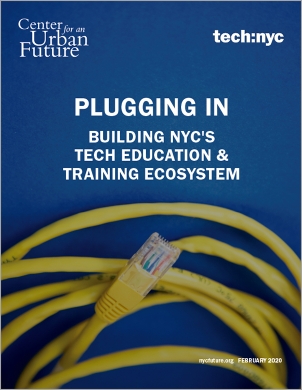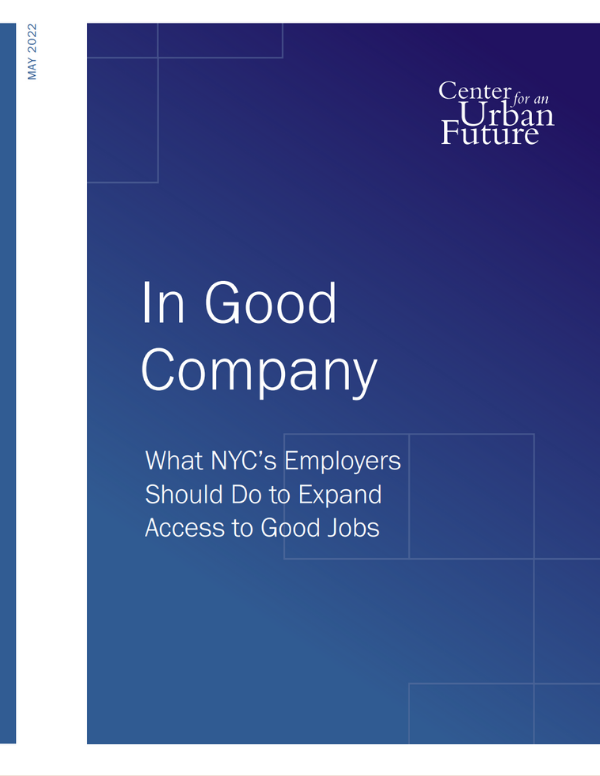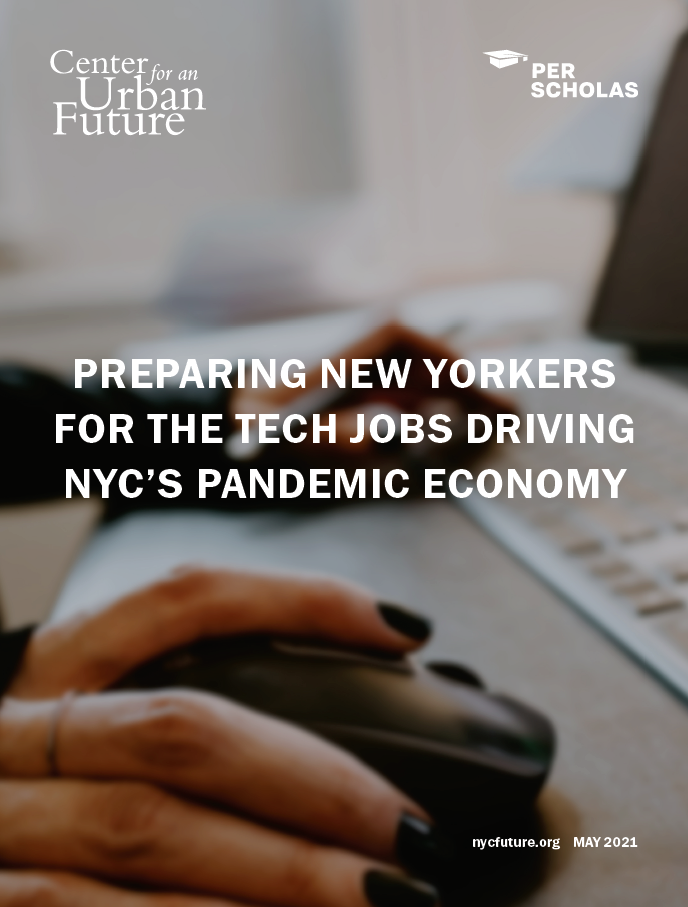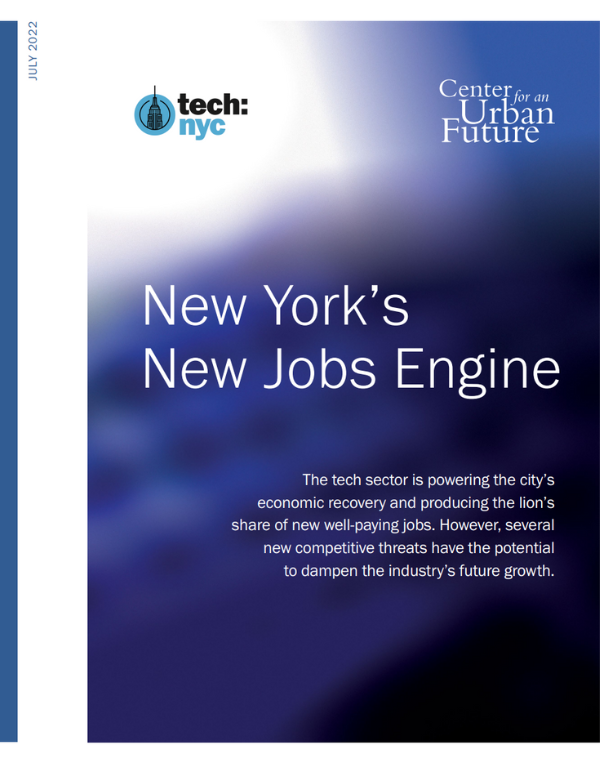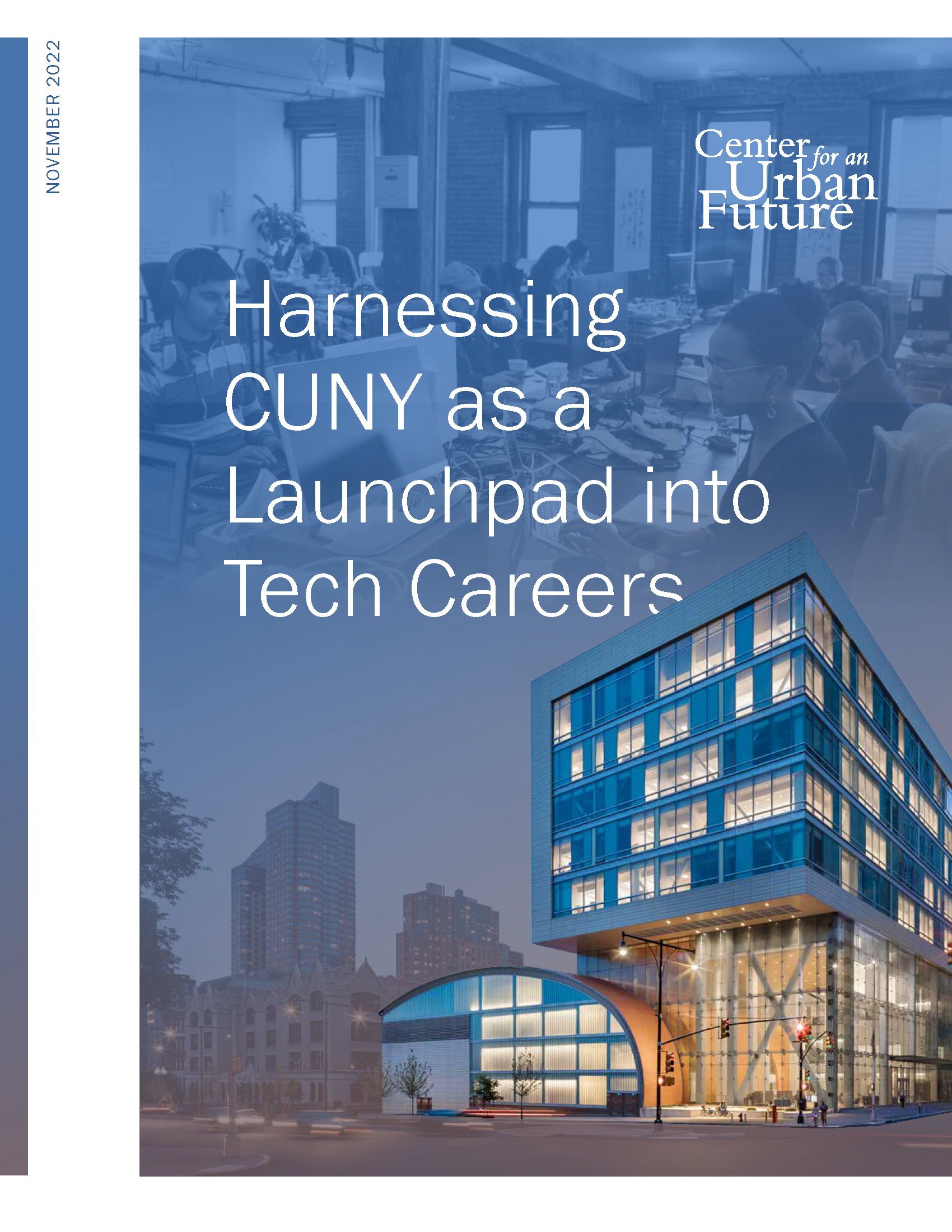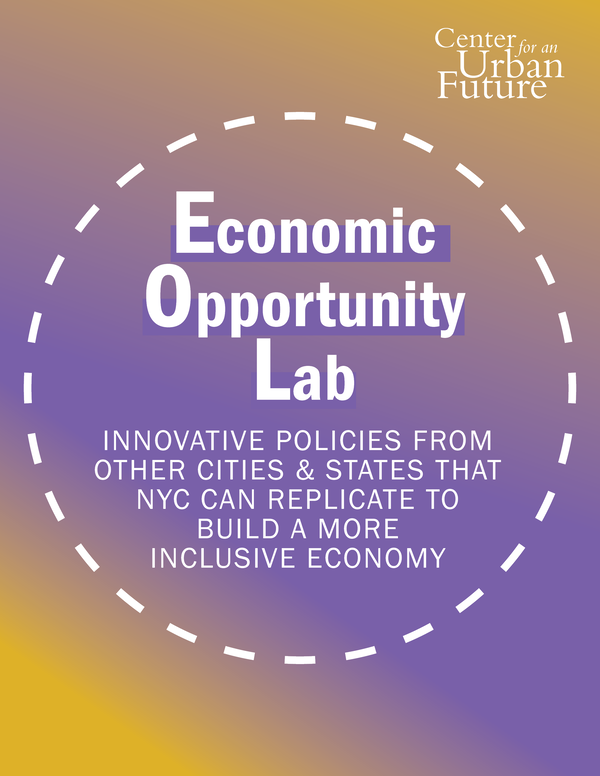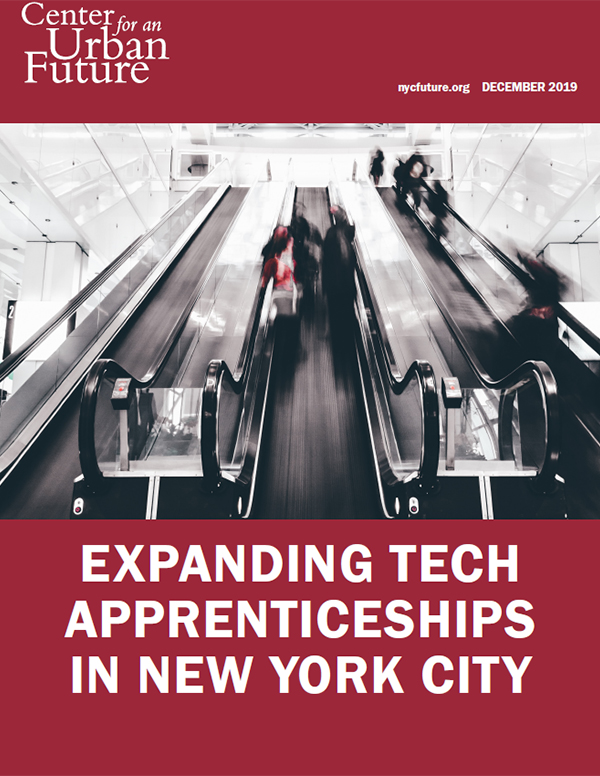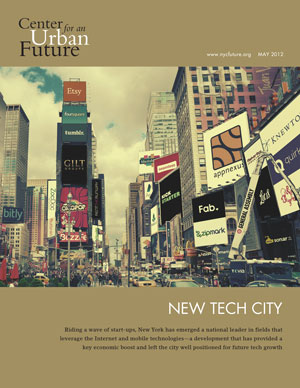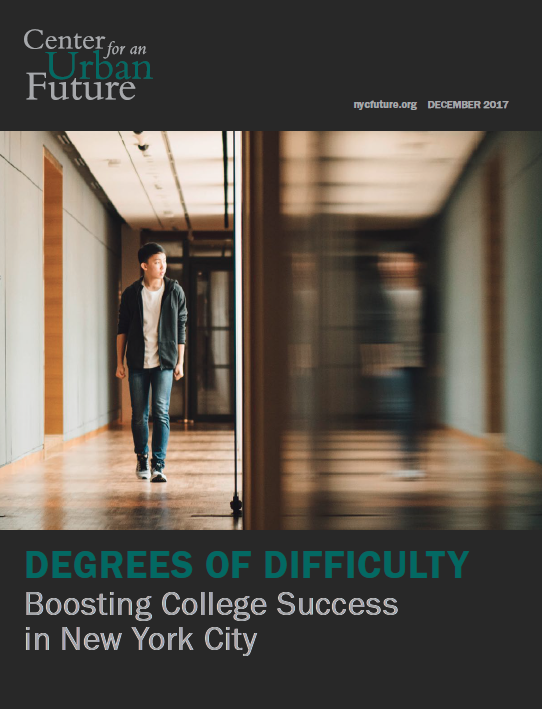For New York City to succeed in elevating far more New Yorkers from lower-income backgrounds into the middle class, the city will need to make significantly more progress in expanding access to technology careers. Over the past decade, jobs in technology have been among the fastest-growing occupations in New York, and the tech sector has become the city’s most reliable source of new well-paying jobs. But even as demand for tech talent grows, too few of those good jobs are going to New Yorkers from low-income communities.
This is no small problem for New York. The troubling opportunity gap that exists in the city’s tech workforce is exacerbating inequalities across the five boroughs. It also threatens the economic competitiveness of the city’s tech sector, which is already experiencing a talent shortage and will need to tap more of the local workforce to sustain its growth.
Tackling this will require change on multiple fronts: wholesale improvements in the city’s education and workforce training systems; stronger commitments from employers to hire, train, and retain diverse local talent; and major new investments that expose New Yorkers to these careers, introduce them to foundational skills, and help them develop the specific competencies and hands-on experience that are in demand at tech companies today.
This report points the way forward, providing the first-ever comprehensive assessment—and map—of New York City’s tech education and training ecosystem.
Our study, which takes a close look at both computing education programs focused on children in the K–12 system and adult-oriented tech workforce training programs, finds that the city’s tech skills-building ecosystem has come a long way in recent years. There are now at least 238 tech education and training organizations operating 506 programs in 857 locations across the five boroughs, and that does not include the exciting work underway in city schools to deliver on Mayor de Blasio’s commitment to offer computer science in every public school by 2025.
However, we also found striking geographic disparities, programming gaps, and capacity challenges, which limit access for underserved communities and make it more difficult to develop a diverse pipeline of talent for the tech sector. For instance, our analysis shows that tech skills-building programs are unevenly distributed across the city, with Manhattan home to significantly more programs than any other borough. We found that 11 percent of the city’s Census-defined neighborhoods have just one program identified in our survey, or none at all.
There are also gaps in the types of programs being offered. The city has relatively few programs focused on children in grades K–5, a potential problem given growing evidence that early exposure to foundational STEM education can make a big difference in closing achievement gaps for low-income students and shaping early attitudes toward technology careers.1 Similarly, not enough of the K–12 programs are focused on developing computational thinking skills, though researchers and tech employers say that introducing young people to core concepts of computational thinking is an essential building block for future success in tech fields.
Similar programming gaps exist on the adult side, with consequences for both job-seekers and tech employers in search of job-ready talent. Our analysis shows that more than three-quarters of tech training programs accessible to low-income adults around the city are focused on basic digital literacy or introductory computer skills, with only a small number of programs offering the sort of in-depth skills training that can lead to a tech job in relatively short order. Meanwhile, where the more in-depth skills-building programs do exist, they tend to serve at most a few dozen to a few hundred people per year—even as the city adds thousands of technology jobs each year. In addition, few programs connect from one skill level to another, making for a disjointed array of programs rather than a continuum.
There is much at stake for New York to address these challenges and build on recent successes. Expanding access to tech careers is one of the city’s best opportunities to reduce inequality and expand pathways out of poverty. At the same time, the tech sector has become a major new engine of the city’s growth, and companies throughout the sector are hungry for more skilled workers. To realize this enormous opportunity, city leaders should take decisive action to foster a stronger skills-building ecosystem that can prepare thousands more New Yorkers for the jobs of the future.
This report—and accompanying map—provides a new level of detail about the educational and workforce training infrastructure that currently exists in New York City to help New Yorkers develop the range of skills needed to access technology careers, and assesses how well these programs are aligned with the tech sector’s evolving workforce needs. Researched and written by the Center for an Urban Future in partnership with Tech:NYC—and generously supported by the Robin Hood Learning + Technology Fund, Google, Bloomberg, and Verizon—the report draws from more than 130 interviews with tech executives, skills-building program directors, educators, city officials, nonprofit leaders, researchers, and philanthropic funders.
The centerpiece of the report is a series of 71 profiles of skills-building organizations focused on both students in grades K–12 and working adults, which provides a deeper dive into many of the key organizations teaching a range of tech skills to New Yorkers of all ages.
One of the clear takeaways from our research is that the fast-growing technology sector represents a golden opportunity for New Yorkers from low-income backgrounds to springboard into the middle class, but that a significant disconnect exists: tech companies are hungry for skilled workers and increasingly eager to hire locally, but the city’s current skills-building ecosystem is not yet up to the task. New York today provides insufficient access to high quality educational and training opportunities in technology for many residents from low-income communities. The result is that too few New Yorkers gain the hands-on skills training, educational experiences and credentials, and professional networks needed to spark successful careers in tech.
The shortcomings of New York City’s tech talent development infrastructure are beginning to affect the city’s tech sector. Over the coming decade, New York City is projected to add tens of thousands of new jobs in tech fields, most of which will pay salaries well above the median. But company leaders say that growth could be at risk unless New York’s tech companies are able to access a larger pool of well-prepared local talent. Indeed, according to a 2018 survey of New York City’s tech companies conducted by Tech:NYC and Accenture, 83 percent of tech companies planned to increase tech hiring in the year ahead, but just 50 percent said they were confident in finding the talent they need locally and nearly half said they will not be able to innovate at the same pace if they can’t find the talent they need.2
Some of those talent needs are being met by New York City’s higher education institutions. Columbia University, New York University (NYU) Tandon School of Engineering, Cornell Tech, and the City University of New York (CUNY) are all producing highly skilled and qualified STEM graduates in increasing numbers. But meeting the growing demand for local tech talent among New York City employers—while also seizing the opportunity to lift far more New Yorkers into the middle class by expanding access to careers in technology—will require a more comprehensive, cradle-to-career approach to sparking interest in technology and cultivating computing skills.
To better understand the strengths and gaps in that system today, this report examines the full landscape of skills-building and exploration programs available to young New Yorkers in grades K–12, as well as the tech training programs aimed at working adults. Our research finds that while this skills-building ecosystem is larger and more robust than ever, significant gaps and challenges remain—with consequences for the intersecting goals of diversifying hiring in the fast-growing tech sector and greatly expanding economic mobility for New Yorkers from low-income communities.
New York City’s tech skills-building ecosystem is larger and more robust than ever.
New York City is home to hundreds of programs across a range of tech skills, from coding camps and robotics classes for children and teens to workforce training programs in IT support and bootcamps focused on software engineering or data science. For children and young adults in grades K–12, our research examined in-school programs operated by nonprofit organizations, after-school programs, summer programs, and programs provided by libraries, museums, colleges and universities, and other civic institutions. For working adults, our research focused on programs that are broadly accessible to New Yorkers from low-income backgrounds, including programs that are free; programs with a deferred tuition model; and programs that offer scholarships and needbased funding opportunities.
Our research finds that New York City’s existing skills-building landscape is diverse and more extensive than is generally understood. We identified 113 organizations offering at least 132 unique programs in the K–12 space across 385 specific locations, as well as at least 125 organizations offering unique programs aimed at working adults across 472 specific locations.
Based on comprehensive interviews with more than 70 of these organizations and an analysis of program data, we estimate that the programs aimed at grades K–12 are serving tens of thousands of students each year, while the in-depth, career-oriented programs aimed at working adults are serving just a few thousand participants annually. At the same time, there are more than 330,000 people working in tech jobs across the New York City region today, and tens of thousands more jobs are projected to be added in the coming decade.3 As a result, the city’s skill-building ecosystem for tech careers is still notably small relative to the scale of opportunities in the sector today and in the future.
City-Led Initiatives to Develop Underrepresented Tech Talent
New York City’s technology skills-building infrastructure includes several important recent initiatives. Launched in 2015, Computer Science for All (CS4AllNYC) is a ten-year, public-private partnership led by the NYC Department of Education (DOE), the Fund for Public Schools, and the Mayor’s Office to deliver computer science education to all of the city’s approximately 1.1 million public school students, with a focus on female, Black, and Latinx students. CS4AllNYC is currently ongoing in more than 700 K–12 schools, and 14 percent of all K–12 students citywide were enrolled in CS4All classes in 2017–18.
The Department of Youth & Community Development (DYCD) provides students in grades three through eight with experiential STEM opportunities after school through the following program models: Comprehensive After School System of New York City (COMPASS), School’s Out NYC (SONYC), Cornerstone (at NYCHA Community Centers) and Beacon (school-based community centers for families). DYCD also administers the NYC Center for Youth Employment (CYE), a public-private effort begun in 2015 to expand work experience opportunities for high school and college students ages 16 to 22.
Launched in 2014, the Tech Talent Pipeline (TTP) works to develop local tech talent in partnership with New York City tech employers. TTP works with about 400 companies to recruit and train underrepresented talent, shape curricula and review RFPs, and develop training programs in fields like web development, data analysis, and software engineering.

Tech skills-building programs are unevenly distributed across the city, and several neighborhoods have very few, if any, relevant programs.
Although New York City benefits from hundreds of tech and STEM skills-building programs and initiatives, our research finds that these programs are highly concentrated in certain parts of the city, leaving many neighborhoods relatively underserved. Manhattan is home to significantly more K–12 and adult tech skills-building programs than any other borough, despite containing just 19 percent of the city’s population. Out of the city’s 55 Census-defined neighborhoods, 17 contain 15 or more program locations. But six of the 55 neighborhoods (11 percent) have just one program or none at all that our research could identify. Although it’s understandable that programs are highly concentrated in Manhattan—near major employers and accessible to public transit—these widespread gaps make it harder for many New Yorkers from lower-income communities to access tech skills-building programs, and limit the pipeline into tech employment. These geographic gaps highlight parts of the city where physical access to tech skills-building is limited, while also pointing to underlying socioeconomic factors that shape broader patterns around access to opportunity.
- The neighborhoods with the highest concentration of K–12 programs are in Manhattan and downtown Brooklyn. Midtown/Chelsea has 18 programs in 32 locations (the most in any Census-defined neighborhood in the city), Greenwich Village/Soho/Battery Park City has 27 programs in 34 locations. Park Slope/Carroll Gardens/Red Hook has 20 programs in 28 locations.
- All but one Census-defined neighborhood in Manhattan has at least 11 program locations (the exception is Washington Heights/Inwood, which has seven).
- In eight Census-defined neighborhoods, our research was unable to identify any specific programs: Jackson Heights/North Corona, Flushing/Murray Hill/Whitestone, Bayside/ Douglaston/Little Neck, and Howard Beach/Ozone Park in Queens; Bensonhurst/Bath Beach and Sheepshead Bay/Gerritsen Beach/ Homecrest in Brooklyn; Pelham Parkway/Morris Park in the Bronx, and Tottenville/Great Kills/Annadale in Staten Island.
- There are four Census-defined neighborhoods where our research team was unable to identify any adult tech training programs: Wakefield, Williamsbridge & Woodlawn in the Bronx; Tottenville, Great Kills & Annadale in Staten Island; Ridgewood, Glendale, & Middle Village in Queens; and Howard Beach & Ozone Park in Queens.
- In-depth programs are highly concentrated in Manhattan and Brooklyn. These programs operate at 96 locations in Manhattan, 35 locations in Brooklyn, and 29 locations in Queens, ten locations in the Bronx, and none on Staten Island.

Role of libraries in expanding access to tech skills
- In many city neighborhoods, libraries play an outsized role in providing access to tech skills training. Across the 15 New York City neighborhoods with the highest number of tech skills-building programs, libraries account for 5 percent of total program locations.
- But across the 15 neighborhoods with the lowest number of tech skills-building programs, libraries account for 27 percent of total program locations.
New York has fewer tech skills-building and STEM exploration programs focused on grades K–5.
Across more than 40 interviews with experts and program managers focused on K–12 tech skills-building initiatives, we heard consistently that early intervention is essential to help increase the share of underrepresented students who pursue further opportunities in STEM. But we found relatively few computing and STEM skills-building and exploration programs designed to reach students before middle school. Citywide, many STEM programs aimed at grades K–12 identified for this report tend to focus on older students and afterschool programs, limiting the diversity and inclusivity of the STEM pipeline by emphasizing more self-selecting opportunities. This exacerbates the city’s pipeline problem, as earlier exposure is likely to have the most powerful effect on encouraging students underrepresented in STEM to pursue computing education and STEM subjects in middle school and beyond.
Our research identified a wide range of free tech skills- building programs aimed at young New Yorkers in the K–12 system, both in-school and out-of-school, ranging from coding classes and environmental science camps to robotics workshops and online curricula for teachers. But across the full landscape of K–12 program locations, we found that fewer than one in three programs is focused specifically on students in grades K–5.
- Our analysis finds that more than 67 percent of current K–12 STEM program locations are focused specifically on students in middle school and high school, while just 33 percent are focused specifically on grades K–5.
- The programs focused specifically on K–5 students are highly concentrated in just a few neighborhoods. Our analysis finds that there are seven such programs in Park Slope/Carroll Gardens/Red Hook, six such programs on the West Side/Upper West Side of Manhattan, four such programs in Brooklyn Heights/Fort Greene, and four such programs in Chelsea/Midtown, giving each of these neighborhoods more K–5 programs than Staten Island and the Bronx combined. By comparison, Park Slope/Carroll Gardens/Red Hook is home to fewer than 7,000 students ages five to nine, while the Bronx is home to more than 101,000.
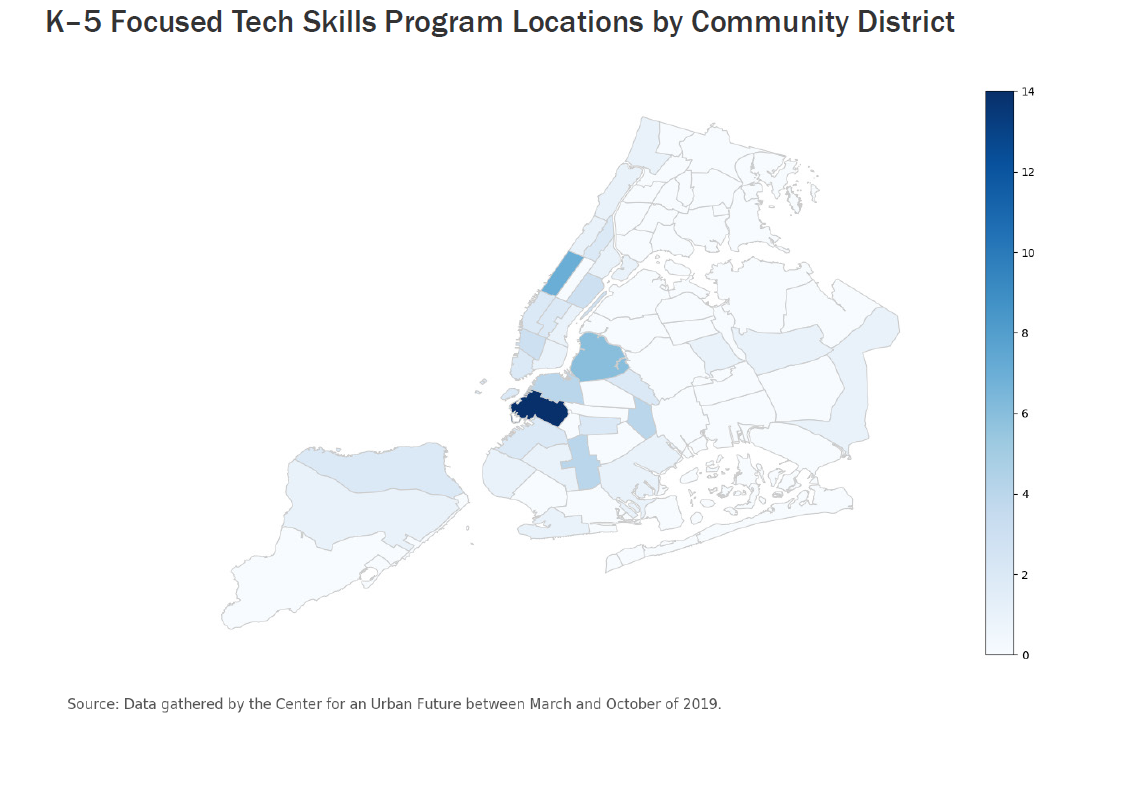
Among NYC’s STEM-focused K–12 programs, a relatively small share are focusing on computational thinking—including just a handful targeted at grades K–5.
While many of the K–12 programs identified in our research integrate computing concepts into their curricula, relatively few have a specific focus on computational thinking skills. The comparatively low number of programs citywide focused on cultivating the full range of computational thinking skills—from decomposition and abstraction to pattern matching and algorithm design—presents a challenge for New York. According to interviews with program directors and educators focused on building foundational tech and computing skills among younger children, there is a growing need for programs that help introduce the core concepts of computational thinking long before children are ever exposed to a coding language—or even a computer screen.
At the same time, interviews with multiple tech company leaders found a growing need for computational thinking skills across all levels of tech sector employment. In order to help students develop the flexible, creative problem-solving abilities that companies are seeking, educational systems will need to prioritize computational learning long before students are exposed to specific programming languages or computer science concepts. Computational thinking can serve as an important on-ramp to computer science: it is broadly accessible to students at young ages, can be widely adopted with existing resources, and can ensure broader exposure to the foundational logic underlying every other tech skill. But these sorts of programs are still in short supply in New York City today, especially among grades K–5, and there is a lack of consensus on what should comprise the required curriculum. Integrating computational thinking intoevery elementary school could greatly expand on-ramps into further computing education and help plug leaks in the STEM education pipeline.
- Our research identified 26 of 132 programs with a specific focus on computational thinking skills (20 percent). These 26 programs are available across 129 locations
- Of these, the majority of these program locations are serving students of high-school age (the total share is greater than 100 as some programs serve multiple age ranges):
- 78 serve 9–12 students (61 percent)
- 51 serve K–5 students (40 percent)
- 30 serve 6–8 students (23 percent)
- Our analysis finds that there are 14 programs with a core focus on computational thinking at 52 locations in Manhattan and 14 programs at 56 locations in Brooklyn. Our research was only able to identify seven programs with a core focus on computational thinking in Queens, three in the Bronx, and one on Staten Island
Computational thinking reflects the ability to break down a larger problem into its constituent parts, logically organize data for analysis, observe and represent patterns and trends through abstractions like models and simulations, assess the underlying logic that generates these patterns, arrange the steps required to solve that problem in a sequence, and evaluate the results. This way of thinking is at the core of scientific hypotheses and experiments, underscores the structure of both natural language and programming languages, and guides processes ranging from identifying patterns and diagnosing problems to designing an object or choreographing a dance. Unlike learning a specific programming language, for instance, computational thinking offers a framework for exploring complex, open-ended problems in a logical way that is applicable across math, science, and the humanities—and these lessons can be integrated into the regular school day.
“We know that students are going to face situations where they will want to build digital solutions to problems, or at least to understand how the digital solutions work,” says Diane Levitt, senior director of K–12 education for Cornell Tech. “Embedding computational thinking in early education can help put those tools in kids’ hands.”
Few of the city’s nonprofit adult tech workforce training programs are focused on in-depth training for tech careers, and only a handful are training for engineering roles.
For adult New Yorkers seeking a skills boost to help prepare for jobs in technology, New York City is home to a range of workforce training and skills-building programs focused on tech and digital skills. In a city with nearly 3.4 million residents over age 25 who lack a college credential, these programs provide an essential source of training and help build ladders into occupations with better wages and greater opportunities for career advancement.4 But our research finds that relatively few of the city’s workforce skills-building programs accessible to lower-income adults are providing the sort of in-depth, career-oriented training that can bridge into tech careers, and just a handful are training New Yorkers for software engineering roles.

• Among free and nonprofit workforce training programs, our research identified just 7 programs out of 158 citywide that offer in-depth, advanced training for coding jobs. By comparison, 80 of 158 programs focus on teaching basic computer skills and digital literacy and 141 of 158 programs focus on basic computer skills, intro-level skills, or entry-level skills. Just 3 percent of program locations teach advanced skills.
• Among free and nonprofit programs, 77 percent of all program locations teach either basic or intro-level skills. In total, 90 percent of program locations teach basic, intro, or entry-level skills.
• Including the full landscape of training providers—which includes nonprofit programs, as well as low-cost for-profit training schools, CUNY continuing education programs, and for-profit bootcamps with scholarship opportunities and/or deferred tuition options—the share of in-depth programs is only slightly larger. Out of the 374 adult training programs overall, 101 focus on teaching basic computer skills and digital literacy. In total, 305 programs focus on basic computer skills, intro-level skills, or entry-level skills.Just 29 programs train New Yorkers for careers requiring advanced coding or engineering skills, and 40 provide career-oriented training for mid-level jobs in tech.
• Our analysis finds that there are no in-depth training programs currently operating in the Bronx or Staten Island with a focus on advanced-level tech careers. Only five programs offer mid-level tech skills training in these two boroughs(while Manhattan is home to 20 advanced programs and 28 mid-level programs).
• In addition, CUNY offers 112 adult continuing education training programs. Among these programs, 19 percent teach basic computer skills, 65 percent offer intro-level skills training, 15 percent teach entry-level, career-oriented skills, and 2 percent provide mid-level skills training.

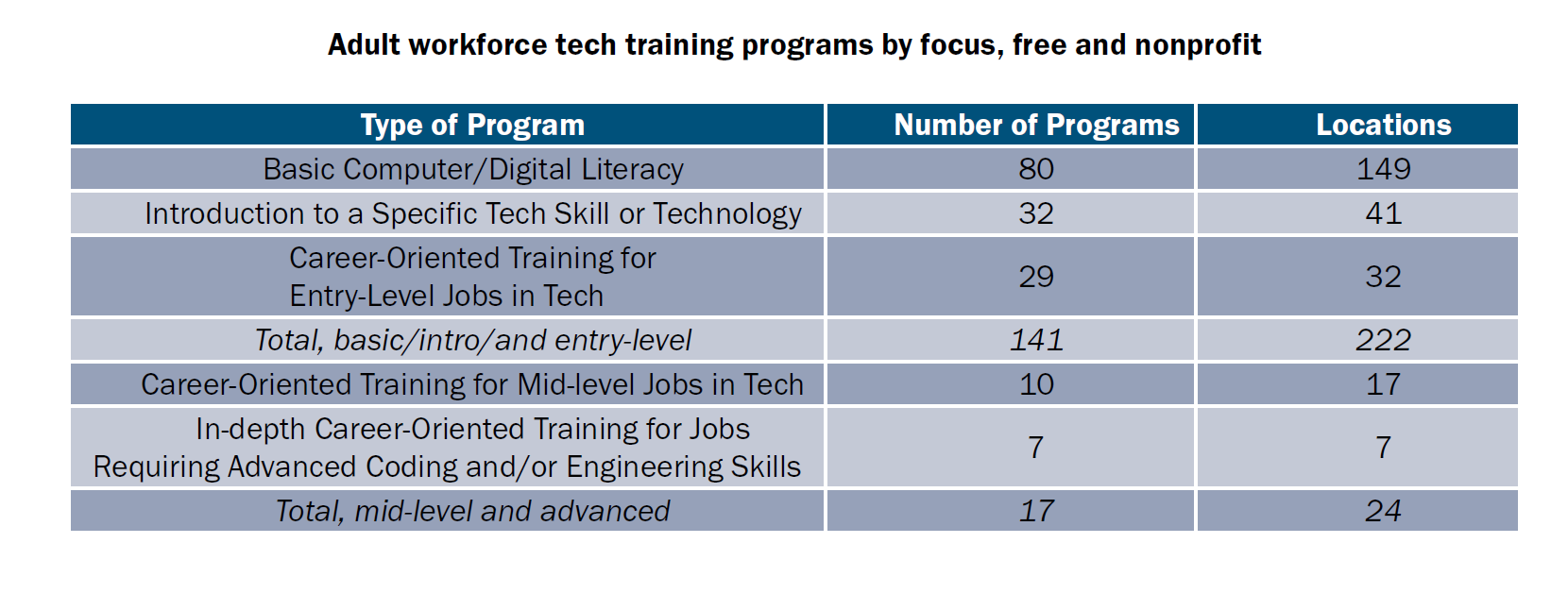
Many adult-focused tech training programs say that preexisting skills deficits—including low literacy levels, math skills, and comfort with technology—pose barriers to aspiring participants. Our research finds that several factors contribute to the relatively low number of adult-focused free and low-cost programs that offer in-depth training for technology careers, including the high cost of providing intensive instruction by industry professionals and the challenge of developing technical curricula with significant input from employers. But for many of the indepth, career-oriented training programs that exist today, organizers say that too few working New York adults are prepared to succeed in their programs. Multiple program managers at the city’s adult-focused tech skills-building providers—specifically those oriented toward careers in tech—told our researchers that a large share of aspiring participants are turned away due to a lack of basic literacy, numeracy, and/or digital skills, or because applicants lack a high school diploma.
These fundamental barriers to tech skills-building and training exist across all five boroughs, but are particularly severe in many low-income communities of color, including predominantly immigrant communities. For instance, while just 13 percent of adults in Manhattan did not graduate from high school, the same is true for 34 percent of adults in the South Bronx and 40 percent of adults in Sunset Park. In total, more than 1.1 million adults in New York City lack a high school diploma, over 1.8 million adults in New York City speak English less than very well, more than 707,000 New York City households lack access to broadband Internet at home, and more than 443,000 households don’t have a computer.5 As a result, many of the in-depth tech training programs interviewed for this report say they’ve had to turn away the majority of aspiring participants due to low levels of basic literacy and math skills. Of the 34 adult programs profiled for this project, 25 percent (9 of 34) say that too few New Yorkers have the fundamental skills needed to succeed in their program. Acceptance rates range from100 percent for nearly all basic and introductory programs down to under 20 percent for the most indepth, career-oriented programs. Among the most selective programs, a lack of proficiency in basic literacy and/or math skills was cited as the single greatest barrier. These more in-depth programs typically require participants to read and do math at a tenth grade level, while more basic digital literacy programs set a lower bar to entry.
“We have too many aspiring participants who are coming in with reading and math levels that are not strong enough to keep up with some of the work and earn a credential,” says Racquel Forrester, former director of the web design and coding program at Opportunities for a Better Tomorrow, a nonprofit training organization based in Sunset Park, Bushwick, and Jamaica, Queens. “This is a huge, systemic barrier specific to the exact populations we want to serve.”
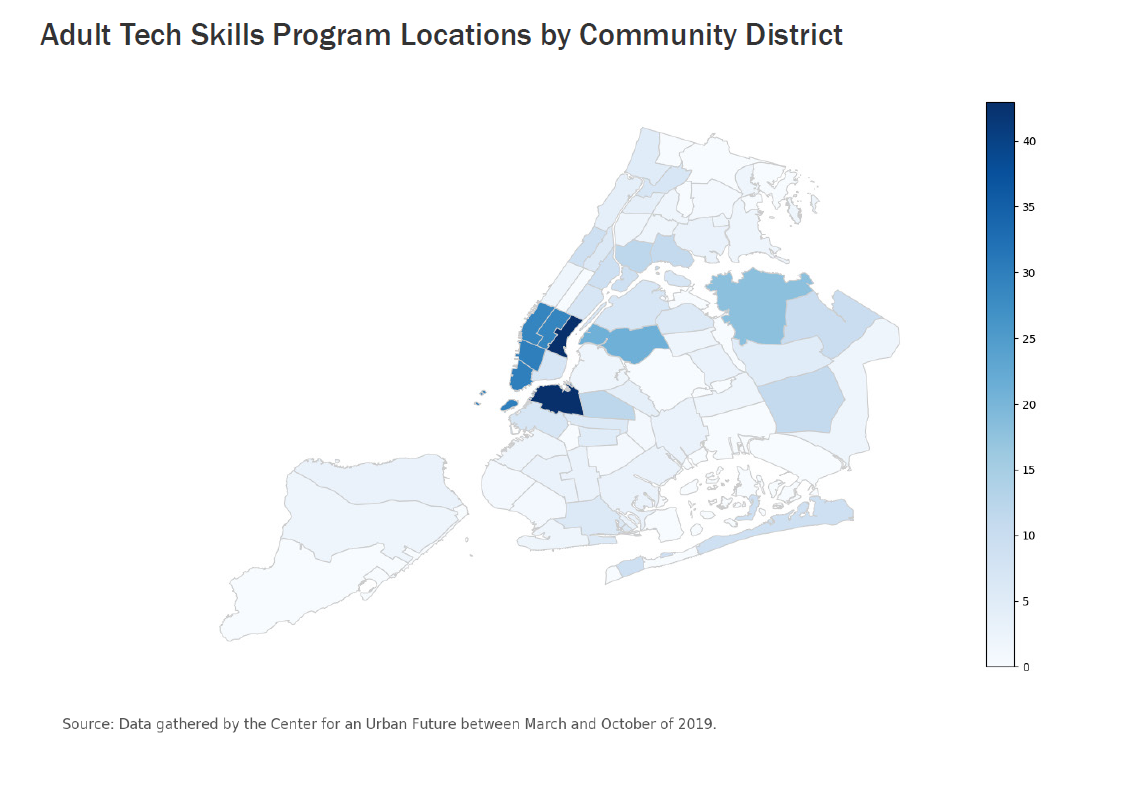
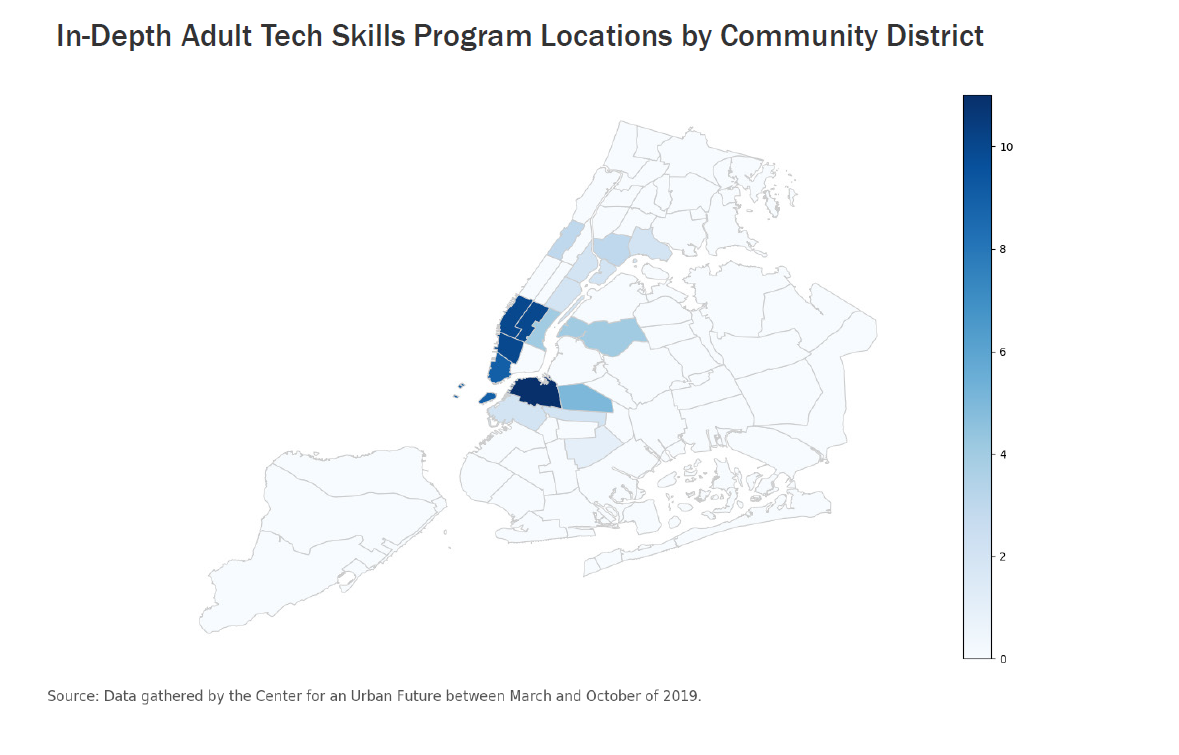
Many organizations are at capacity and are prepared to scale up, but need support to do so.
Across nearly all of the more than 70 in-depth interviews conducted with program managers, one theme emerged again and again: demand for tech skills-building programs is surging, and most organizations lack the capacity to keep up with it. The largest nonprofit workforce training organizations focused on technology are serving no more than 800 participants annually, and most are serving between a few dozen and a few hundred. The K–12 programs identified in our research have the capacity to work with several thousand students, but the city’s public school system contains more than 1.1 million. Many current initiatives could double or triple, according to program leaders, and still struggle to keep up with demand.
Organizations cited a variety of needs to achieve greater scale, including more than just programmatic funding: support for hiring and training instructors; capital funding to expand and improve physical spaces; stronger partnerships with city agencies and other nonprofit organizations; deeper relationships with employers, including those able to offer internships; and more flexible grant funding and city RFPs that can incentivize collaboration.
For both K–12 and adult programs, leaders cited the cost of high-quality programs and the challenge of hiring, training, and retaining skilled instructors as the greatest barriers to scaling up. Of the 38 K–12 programs profiled for this project, 76 percent (29 of 38) say that they have the demand to expand but lack the funding. Of the 34 adult programs profiled for this project, 32 percent (11 of 34) say that they have the demand to expand but lack the funding.
“We have a pay-per-student model that todaya lot of schools are choosing not to pay for,” says Jerelyn Rodriguez, co-founder of The Knowledge House. “We should be able to provide our programs to low-income students of color citywide, but many schools are not prioritizing new STEM programs beyond the current curriculum. Instead, we’ve had to rely a lot more on philanthropy to scale to meet the demand, but that only goes so far.” “
We could significantly expand the number of people served with a sustainable source of funding that allows for flexibility and nimbleness in program design and execution,” says Kelly Richardson, the outgoing managing director of Per Scholas for New York and Newark. “It’s the number one obstacle: funding that takes into account the expertise of providers to build programs that work and that doesn’t come with really onerous oversight and reporting requirements.”
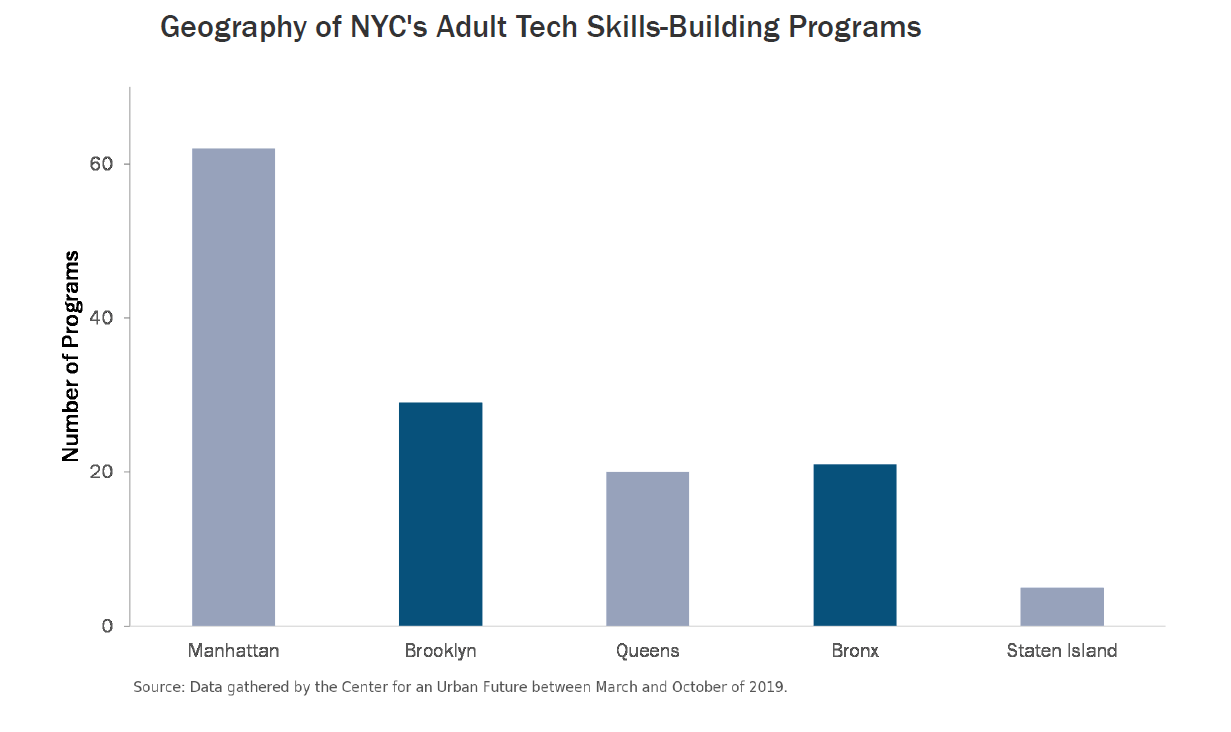
Building a more diverse tech sector will require top-level focus from policymakers and civic leaders and substantial new investments across the skills-building ecosystem.
Expanding pathways into technology careers for more New Yorkers from low-income backgrounds—including Black and Latinx New Yorkers who are significantly underrepresented in STEM fields—will require both significant near-term interventions and a large-scale, generational effort. Black and Latinx New Yorkers face a multitude of systemic barriers in both the education system and the workforce, including implicit bias in hiring, a lack of visible role models in both school and the workplace, and the cumulative effects of generations of underinvestment in families, communities, educational institutions, workforce development programs, and entrepreneurs of color.
But in some important respects the tide is starting to turn. Tech companies ranging from major global leaders to local start-ups are ramping up commitments to diversity and inclusion and increasing transparency around hiring practices, and major citywide initiatives starting with CS4All will greatly expand access to quality computer science education. But to help ensure that far more New Yorkers can gain access to the well-paying, fast-growing jobs being created across the tech ecosystem—and to develop a stronger pipeline of homegrown talent to fuel the city’s expanding tech sector—much more needs to be done. To begin, it will require a new sense of urgency among city leaders that expanding and improving the quality of tech skills-building education should be among the top priorities for policymakers now and in the future. And the city should set clear and ambitious goals around accessing tech education from a child’s earliest years; growing apprenticeship models and reducing barriers to work-based learning; boosting the number of STEM graduates who are Black, Latinx, and/or women; and greatly expanding the number of in-depth workforce training programs aligned with careers in technology.
Building the more diverse tech workforce of the future starts with supporting, expanding, and improving programs in the city’s K–12 education system. Since 2015, CS4All has made major strides in ensuring that every New York City student has access to a computer science education. This initiative should become a key building block of the city’s future investments, while additional resources should be focused on greatly expanding early integration of computational thinking. These investments should be targeted to close persistent gaps: for instance, our research finds that the broader landscape of K–12 STEM programs are still heavily weighted toward high school. By that time, most students have already decided for themselves whether STEM fields and computer science is for them—leaving behind far too many girls and young people of color who have not been exposed to STEM experiences earlier and don’t see themselves represented in the field. Developing excitement around technology and confidence in STEM skills needs to start from the beginning of a child’s education, requiring deeper and more consistent opportunities to develop computational thinking skills from kindergarten forward. Our research finds that setting clear goals and launching new investments in early, integrated computational thinking education across grades K–5 could have the greatest impact on expanding access to technology careers over the long term.
At the same time, tens of thousands of working New Yorkers feel trapped in low-wage jobs with few opportunities for advancement and could benefit from expanded access to quality, career-oriented tech training programs. But far too few of the free and low-cost training programs available to working adults are aligned with tech careers; those that are typically operate at a very small scale; very few of these programs are embedded in low-income communities; and millions of New Yorkers lack the fundamental literacy and math skills required to participate in the most in-depth training. Meeting this growing need will require adding new programs aligned with growing tech occupations, expanding existing programs to meet rising demand, developing incentives and flexible funding streams that incentivize collaboration across the skills-building ecosystem, expanding supports for nontuition costs like transportation and childcare, and ramping up bridge programs that provide crucial upskilling onramps to career-focused education and training.
Endnotes
1. Early Childhood STEM Working Group, “Early STEM Matters,” University of Chicago, January 2017, available at http://d3lwefg3pyezlb.cloudfront.net/docs/Early_STEM_Matters_FINAL.pdf.
2. Tech:NYC and Accenture, “The New York City Tech Ecosystem Is Hiring,” May 2018, available at https://www.accenture.com/us-en/insights/future-workforce/nyc-tech-jobs.
3. There is no one way to calculate the total employment in New York City’s tech sector, but a 2018 estimate by Forrester Research finds 333,000 tech jobs across the New York region. Of these, at least 146,000 jobs in New York City are located in the seven industries that comprise the Federal Reserve
Bank of New York’s definition of the tech sector, focused on industries “in which firms use technology as their core business strategy.”
4. Center for an Urban Future analysis of data from the U.S. Census American Community Survey, 2013–2017.
5. Center for an Urban Future analysis of data from the U.S. Census American Community Survey, 2013–2017.

